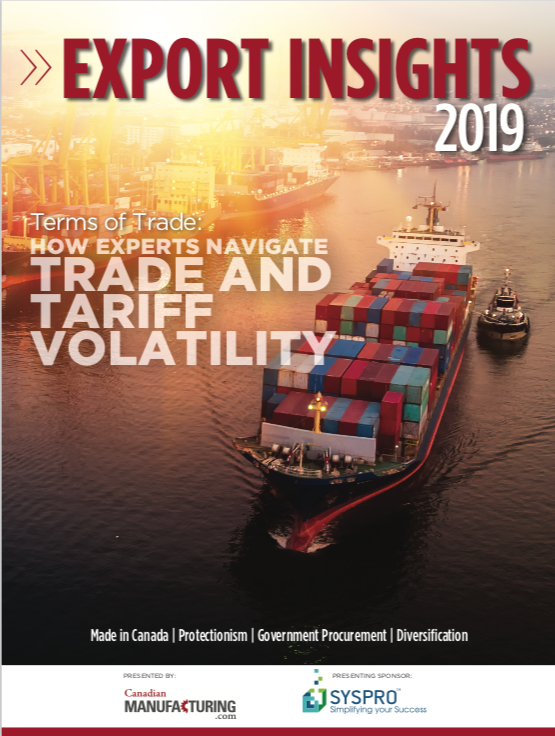
Terms of trade: How experts navigate trade and tariff volatility
Rehana Begg

The 2019 Export Insights report delves into exporters’ current level of overseas trade, and asks about their perceived challenges, knowledge gaps and proven success strategies

PHOTO: From left to right: Dale Kehler, Walter H. Weber, Gwenaële Montagner, Geoff Atkins, James Johnson, Gregory Rust, and Andrew Ellis
When CanadianManufacturing.com invited a panel of experts to weigh in on data from our national exporting survey, an overarching sentiment emerged: The U.S. has always been, and remains, the export market where Canadian exporters focus their efforts, but exporting companies would be wise to prioritize diversification.
Highlights of the panel discussion, along with the survey results, can be found in the 2019 Export Insights report.
 The panel of manufacturing and industrial sector executives said the unpredictability in the future global trading system, uncertainty around international trade policy, and backlash from protectionist rhetoric and dominant players have made exporting companies vulnerable as they consider expansion to foreign markets.
The panel of manufacturing and industrial sector executives said the unpredictability in the future global trading system, uncertainty around international trade policy, and backlash from protectionist rhetoric and dominant players have made exporting companies vulnerable as they consider expansion to foreign markets.
For the 2019 Export Insights report, more than 178 exporting and non-exporting executives were asked to share where their sales are concentrated and where they see opportunities for growth. The report also delves into the operating environment and how geo-economics affects trade and trading relationships, and uncovers strategies for new and mature exporters.
The survey results reveal the following:
- The report reveals that Canadian manufacturing companies that export make 40% of their revenues from exports, on average. Consistent with market expectations, 93% of respondents export to the U.S. Mexico is the runner-up, at 35%, followed by the U.K. (27%), Western Europe (26%), Latin America (25%) and other Asia markets (22%). Exports to China came in at 20%.
- Half of the companies surveyed have seen their export volumes change for the better in the last year; 11% reported a significant increase, 39% reported “somewhat increased” export volumes, and 36% reported the volume remained the same. The remainder, 14%, reported a net decrease.
- When asked whether they plan to enter a new market within the next two years, 51% of respondents reported they are definitely exporting to new markets or considering the idea.
- The Trump Effect: 66% of firms have made, or plan to make, some level of adjustment to their export strategies because of the Trump administration. Only 34% are staying the course.
- A new question in the 2019 report: How often do you sell your products and services to governments outside of Canada? Less than half (41%) of respondents sell products and services to governments outside of Canada, while 59% “never” sell to foreign governments. Respondents list unexpected costs such as tariffs (29%) as the leading obstacle when dealing with foreign governments. In addition, regulatory hurdles impacting shipment (29%) and supply chain breakdown/lack of visibility (13%) are also noted as drawbacks.
Click here to download a complete copy of the report.
—
The 2019 Export Insights report was developed by CanadianManufacturing.com, in partnership with SYSPRO, a global, independent provider of industry-built ERP software, and conducted by an independent research firm. The report highlights data from a national survey of nearly 178 Canadian industrial executives. The report is augmented by a roundtable discussion among Canadian exporters.